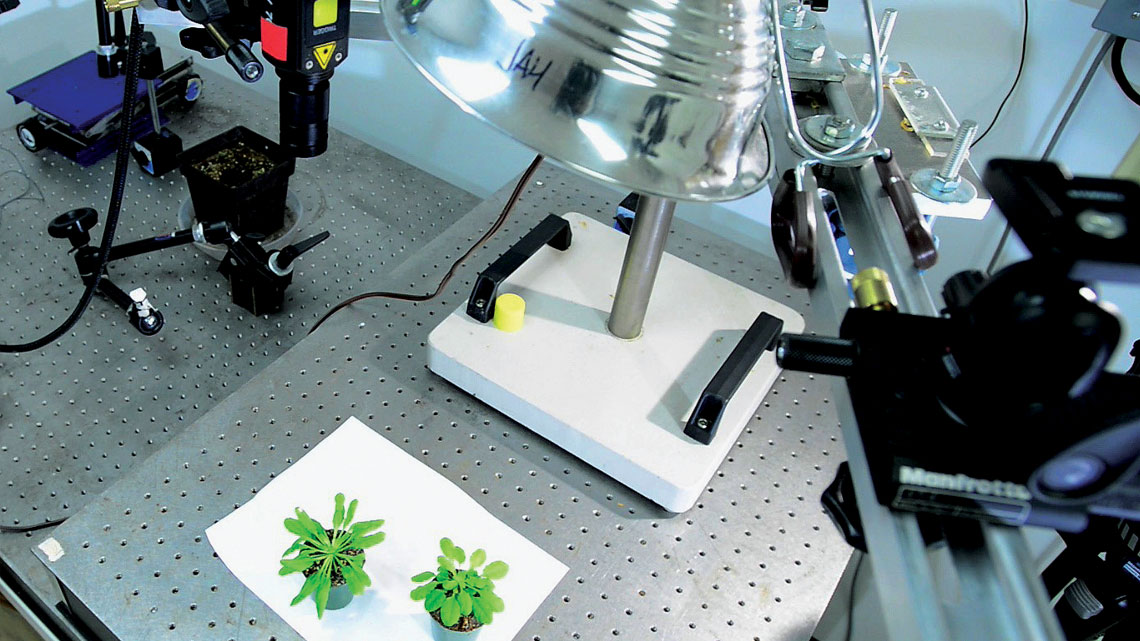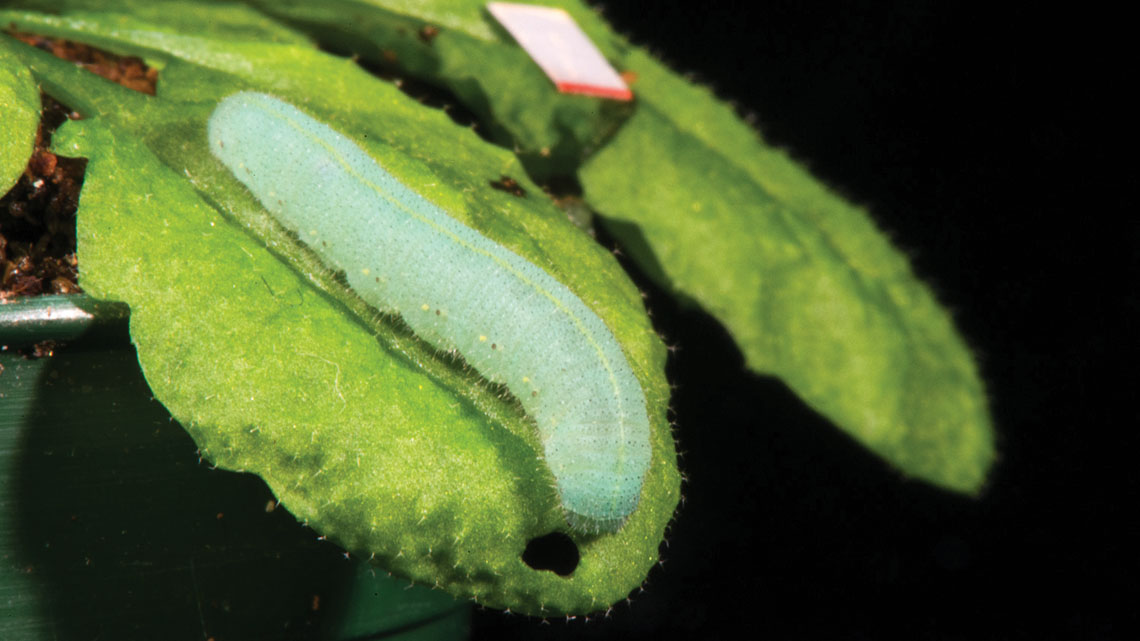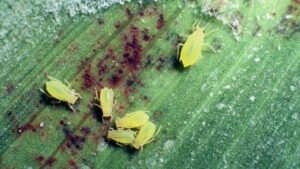New research shows when caterpillars bite into a leaf, plants can detect chewing vibrations and mobilize chemical defenses.
University of Missouri researchers have discovered that Arabidopsis mustard plants can detect the chewing vibrations of caterpillars, which mobilize the plants’ chemical defenses. While the research is still in its infancy, it could have implications in agriculture’s battle against chewing insects.
Heidi Appel has spent her career studying how plants recognize that insects are attacking them. As an investigator at the University of Missouri’s Bond Life Sciences Center and senior research scientist in the College of Agriculture, Food and Natural Resources Division of Plant Sciences, Appel wanted to know more about how plants reacted and how a plant’s chemical defenses worked, or were enhanced, when insects began feeding.
Across campus was Rex Cocroft, a professor of biological sciences in the university’s College of Arts and Science, who had also dedicated part of his career to studying how plant-feeding insects produce and detect vibrations traveling through their host plants. His decades-long studies on treehoppers have found that insects can send certain signals through plants.
For example, if a female treehopper detects a predator, she will send a vibration through the plant causing her offspring to fall off the plant.
It was by chance the two researchers began talking about their experiments during a university-hosted presentation. Cocroft began telling Appel about a technical problem he often experienced in his tests: whenever a chewing insect showed up, they would have to shut down the experiment because the feeding was so loud.
Appel and Cocroft knew right away their research could complement each other’s and could perhaps shed more light on how vibrations caused by insects’ chewing affect plants.
An Ideal Collaboration
They began their experiment in 2008 as a sideline to their individual research programs.
First, Appel and Cocroft made a library of 22 different caterpillars’ feeding using a technique developed by the Cocroft lab. A laser beam is focused on a small piece of reflective tape put on a leaf, where it measures minute deflections caused by small movements of the leaf when caterpillars feed.
“When the caterpillars are sitting on the leaf and just feeding, the whole leaf might not move more than one ten-thousandth of an inch,” Appel explains. “This specialized laser captures that movement — that vibration — as an electrical signal. We can then make the vibration audible by shifting it into a human’s hearing range.”
Once Appel and Cocroft had the library of caterpillar feeding vibrations, they could then test whether these chewing sounds created more chemical defenses in the plants by playing back the vibrations to the plant. To do this they used a piezoelectric actuator — a tiny speaker that allowed them to play back the vibrations — they were able to mimic the caterpillar chewing sounds.
Using a group of Arabidopsis mustard plants, they attached actuators to the leaves using wax. Half the plants received sound; the other half did not. For two hours, they played a continuous loop of feeding vibration mimicking a caterpillar’s typical plant feeding cycle.
Scientists have long understood that glucosinolates are what make mustard plants spicy. This spiciness can act as a defense mechanism for the plant against many insect pests. Appel noticed that when glucosinolate levels spiked, some insects would stop feeding or move away without starting to eat at all.
Typically when insects attack plants, plants resp-ond in one of two ways. Sometimes the level of chemical defenses is raised right away, but sometimes not. “Instead they are just primed to get their machinery ready to make those defenses,” Appel explains.
After giving the plants 24 to 48 hours to respond to the caterpillar attack, the researchers tested the leaves for the presence of the chemical. Appel and Cocroft found plants that received feeding vibrations made more glucosinolates.
They then tested a leaf on the other side of the plant, not connected to the actuator, and learned that it, too, made more glucosinolates. “Just like humans, plants are good at communicating with their entire body,” Appel says.
At this point, Appel and Cocroft knew they were on to something. “We were very fascinated, but plants also experience other vibrations in the environment, such as the wind or insect song,” Appel says. “Were these plants just responding to any vibration in the environment, or specifically to the caterpillars?”
Plants Can Detect Difference in Vibrations
In continuing the research, Appel and Cocroft added other vibration sources to their tests: a gentle wind and the call of a leafhopper.
They discovered the frequency of those vibrations was very different. This time Appel analyzed a different plant defense — anthocyanin. They again found the plants made more anthocyanin when they were exposed only to chewing vibrations, but not vibrations created by the wind or the sounds of a non-harmful insect such as the leafhopper.
“This was a second line of evidence that the plants were responding to feeding vibrations and could tell them apart from the wind,” Appel says.
This is the first time scientists have shown that a plant responds to an ecologically relevant sound in its environment, she adds.
Future Research
Research continues with new funding from the National Science Foundation. Future research by University of Missouri scientists will include looking into quicker and less expensive ways to detect plant responses. Right now experiments take two weeks to run, plus a couple additional weeks of chemical analysis.
“This was a second line of evidence that the plants were responding to feeding vibrations and could tell them apart from the wind.”
— Heidi Appel
Appel and Cocroft are also collaborating with two other labs working on mechanoreceptors, used by all organisms to detect pressure. These labs have created a series of mutants lacking certain mechanoreceptors that will be used to determine if mechanoreceptors are involved in the plant’s response to feeding vibrations. “If a regular plant responds to the feeding vibrations but a mutant plant does not, then we know mechanoreceptors
are involved,” Appel says.
By playing back different components of the vibration signal, they are also trying to determine what characteristics of the feeding vibration trigger a plant’s response.
Appel and Cocroft will conduct their tests with more kinds of chewing insects, and in more kinds of plants. They plan to next use Brassica plants, the source of all cruciferous vegetables, such as broccoli and cauliflower.
“We expect this response to be universal in plants, but our work over the next two years will allow us to confirm this,” Appel says.
The study, “Plants Respond to Leaf Vibrations Caused by Insect Herbivore Chewing,” was published in the journal Oecologia.
For a video about this research, visit youtube.com/watch?v=TKQ-CIX9afA

















